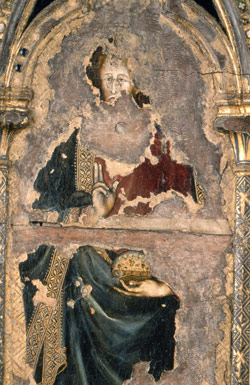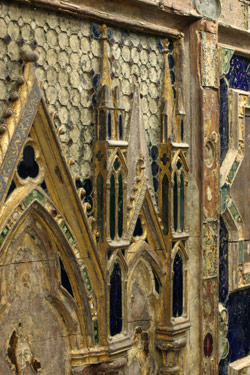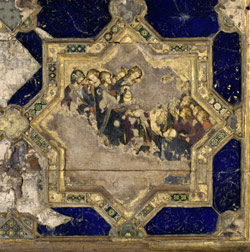by Dr Spike Bucklow
The Westminster Retable is a large (959 mm by 3330 mm), mid-thirteenth-century altarpiece constructed from English and German oak and painted in linseed oil. It was painted, around 1260, for the high altar of Westminster Abbey.
 |
||
|
© the Dean and Chapter of Westminster The Westminster Retable |
||
Conservation background
The Retable is Britain’s oldest surviving altarpiece on panel and has spent most of its 750 years in and around Westminster Abbey. It has had a varied history of use and the condition of its surviving paint and gilding gave cause for concern in the 1980s despite in situ treatment through the 1970s. In 1986, a symposium was held at the Abbey to consider its conservation. In 1987, a three volume report on the Retable was produced which examined its structure and condition, proposed some treatment to be undertaken in a studio within the Abbey, and addressed the issue of its environment. The National Gallery Scientific Department took samples and undertook analysis and, in 1989, the Dean and Chapter invited plans and estimates for the Retable’s conservation. A tender by a private conservator was accepted in 1990, and funding was sought but, by 1992, it was acknowledged that the work required the research resources of a large, established conservation studio.
The Institute was formally asked to undertake the project in 1993. An outline proposal was submitted to the Getty Grant Program in 1994, and a final version submitted in 1995. A grant was offered in 1996, and at the same time further support was sought from the Heritage Lottery Fund, which was approved in 1997. Meanwhile, relative humidity and temperature levels were monitored in the Abbey and within the Retable’s display case, whilst, at the Institute, preparations were being made to receive the Retable.
 |
 |
||
|
Left: © the Dean and Chapter of Westminster Detail of the Westminster Retable depicting Christ cradling the Earth Right: © the Dean and Chapter of Westminster Detail of the Westminster Retable showing the relief construction |
|||
The Retable was prepared for transport at the Abbey and moved, in 1998, to the Institute where it was placed on a rigid trolley within a climate controlled tent in a climate controlled studio. Detailed visual examination started immediately, supplemented with X-radiography, dendrochronology, pigment and medium analysis, etc. The dynamic behaviour of the structure was also monitored in order to understand the Retable’s response to its environment. This involved a series of photogrammetric measurements, undertaken by the Department of Geomatic Engineering, University College London.
The treatment of the Westminster Retable followed and overlapped the treatment of the Thornham Parva Retable (1994-2003) and experience indicated that such projects required sophisticated documentation. The Westminster Retable is a complex assembly (the substrate is six oak boards, reinforced by eleven oak battens, ornamented with scores of small pieces of carved oak, covered in gilding, paint, and decorative elements including 1,250 imitation gems). The conservation team consisted of specialists in paint, glass, metal and wood, all dependent upon photographers and the results of scientific examination (provided both in-house and by international experts). All aspects of the examination and treatment (which took seven years) were available for inspection by all concerned. Conservators needed to keep track of their own work and needed to co-ordinate their work with the work of others, and an accessible record was required for all involved in the Institute and Abbey.
In order to support and coordinate the efforts of all concerned, a database with a graphic user interface was developed collaboratively between the Institute and members of the Department of Geomatic Engineering, UCL. The database used photogrammetrically accurate images of the Retable together with mosaic of X-rays, in a manner based upon systems developed in project management software and geographic information systems. The database stored dimensional information, and details of the structure, condition, scientific analysis and treatment of all discrete elements. Approximately 5,000 elements ranged from oak boards, to glass gems and included complex composites such as imitation enamels.
The painting
The support consists of six oak boards, joined with 31 square-section iron dowels. The four horizontal boards are locally sourced timber from the Thames Valley, and the two vertical boards at either end are from North Germany. The structure was reinforced by eleven battens on the back and elaborated by carving into the front as well as attaching scores of small carved oak pieces.
The Retable was initially designed as a central section, depicting Christ, Mary and St John, flanked on each side by four painted scenes from the life of Christ. The structural work, carving and detailed decorative planning for this part of the Retable was taken to a high degree of finish before the design was changed and the whole Retable was extended. The extentions, depicting St Peter on the left hand side and presumable St Paul on the right hand side, were added by the same carpenters, working in the same manner and the whole Retable was prepared for polychromy together.
Metal ribbons and trays were attached to the sized wood to provide support for imitation enamels. The surfaces that underlay framing elements were coated with a chalk ground and the surfaces destined for figurative painting were coated with gypsum in animal glue. Linseed oil putty was applied directly to the sized wood in areas that were to be glazed. Various types of gilding, both with gold and silver leaf, were applied to the ground layers and also to oil mordants. Blue glass was placed over silver leaf and patterns were painted over gold leaf in the imitation enamels. Gold leaf was also punched, burnished and glazed in different areas to achieve a variety of visual effects. The paint was linseed oil-based and applied with consummate skill.
 |
||
|
© the Dean and Chapter of Westminster Detail of the Westminster Retable showing a scene depicting The Feeding of the Five-thousand |
||
The Retable would originally have looked like enamelled metalwork although the reverse, which would not have been seen, was painted to imitate porphyry. It had been taken down from the High Altar by the sixteenth century and was reused as the lid of a chest in the eighteenth century. In the early twentieth century, it was given its own display case in the South Ambulatory. At some stage in its history, the Retable was vulnerable to vandalism and most of the imitation gems were stolen. This, combined with a continued loss of parchment strips, paint and gilding, exposed significant areas of wood and severely compromised its appearance as imitation metalwork.
Conservation work involved stabilising the paint and gilding, cleaning the glass and thinning the varnish. Restoration work was limited to reducing the visual impact of losses. No retouching of the paint or gilding was undertaken. A partial reconstruction was made in parallel with the conservation treatment as part of the Institute’s postgraduate training programme and the reconstruction is on display next to the Retable in the Abbey Museum. After a three-month exhibition at the National Gallery, the Retable returned to the Abbey in October 2005, in time for the 1,000th anniversary of the birth of St Edward the Confessor.
Publications
- P. Binski, A. Massing (eds.), The Westminster Retable: History, technique, conservation (Painting and Practice), Brepols Publishers [Hardback: ISBN 978-1-905375-28-8]
Below are links to some further articles about the conservation of the Westminster retable. The first two were originally published by the International Institute for the Conservation of Historic and Artistis Works (IIC) and are reproduced here by kind permission of the IIC.
- Bucklow, S., “New Age Old Masters”, The Object in Context: IIC, London, 2006, pp. 267-272.
- Bucklow, S., “Stories from a Building Site”, Conservation and Access, ed. D. Saunders, J.H. Townsend, and S. Woodcock: IIC, London, 2008, pp.126-9.
- Westminster Retable; Table of Contents
- Westminster Retable; Editors introduction
- Westminster Retable; Photographic Survey After Treatment
